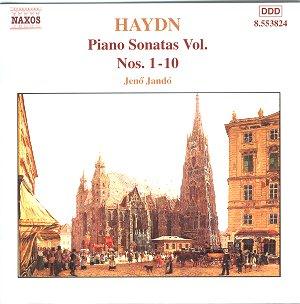Joseph HAYDN (1732-1809)
Piano Sonatas Vol. 10, nos. 1-10.
 Jeno Jando
Jeno Jando
rec. Phoenix Studio, Budapest, at the Unitarian Church, February 1996.
 NAXOS 8.553824
[70.47]
NAXOS 8.553824
[70.47]
Crotchet AmazonUK
AmazonUS

Listed Comparison
John McCabe, The Piano Sonatas, Decca 443-785-2 (12 CDs) rec. 1974-7,
All Saints' Church Petersham
Jando must be nearing the end of his odyssey, taking longer than John McCabe
because of so many other commitments. The vernal consensus is a matter of
preference: Jando's crisp no-nonsense playing is generally brisker than McCabe's
unreconstructed but still scholarly, modern readings. Both use modern pianos,
both are aware, to some extent, of period practice, Jando benefiting from
another 20 years of it. Even the cost doesn't enter into it; if Jando runs
to 12 CDs the cost will be almost identical. McCabe's Decca packaging has
the advantage on shelf-space. Neither Ronald Brautigam on period instruments
nor some of the one-off Haydn players have challenged this duo. Brautigam
lacks sparkle, and Staier hasn't entered into this arena. Nor Levin or Tan.
These are the earliest works, dating from c. 1763-67, thus those most likely
to benefit from the Jando approach. Several are spurious, though scholarship
tends to favour them; and No. 5 for is a composite. The sound is quite close,
and McCabe himself benefits from a beautifully caught piano sound, crystalline
and with plenty of air around it. The piano timbre itself is quite close
to a fortepiano, as it happens. Jando's pianism is crisper, less rounded
and shaded. In these works a correct classicism like Jando's would appear
to be more authentic, but they're very much the earliest works and benefit
from as much advocacy as possible. McCabe coaxes out of the first in G major
an extra few seconds of expressiveness, and out of No. 7, which has at its
heart a theme and variations, an extra level of fantasy. Jando lays out the
variations more crisply, bringing out the structure particularly well. For
his part Jando addresses the piano with terrific ebullience and forward drive
that again these works need. The end of No. 5 in G, for instance a composite
work (its opening is also the finale of No. 4!) benefits from Jando's more
hard-driven approach. Yet the heart of this minuet seems beautifully held
by McCabe in a terracing of small intensities before the return of the opening
whisks it off into G strings. Again, McCabe's handling of the close of such
movements as No. 6 in C is a quiet miracle of fining down. And here he has
the speed edge (like the opening of No. 2 in G) over Jando too.
On the other hand, Jando's fizz with the same work's Presto finale is something
to savour. And his tossing away the finales of most of these works is
tremendously Haydnesque. But, in case this appears too polarised, one should
aver that there's no lack of poetry either in Jando: he too can deploy great
delicacy of touch (the opening of No. 7 again), and the fairly close-miked
sound is excellent; picking up detail but not poking it. And he rushes and
pulls back the Presto of No. 8 in A like a modern child with an antique spinning
top. He pretends he doesn't quite know how to keep it turning, and flips
over the penultimate phrases in a manic speed-up, before elegantly applying
his hands as brakes. And he unpacks the delicate pathos in the Moderato of
No. 9 in D, coaxing it out like some Agostinelli Rococo figurine of a vanished
patron; and puts it back. No, Haydn aficionados will want both. McCabe with
several (or all) Jandos is the best of all possible worlds. Until Staier
comes along.
Simon Jenner

